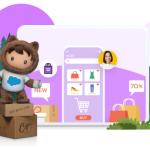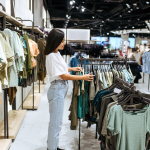Contactless engagement has been the new norm ever since the COVID-19 pandemic upended the commercial landscape in unpredictable ways. Many organisations are scrambling to adapt to a world where the old ways of doing business have vanished. Perhaps no industry has faced bigger challenges than retail, which transformed seemingly overnight.
When lockdowns hit, retailers closed their stores and customers moved towards e-commerce, accelerating the digital imperative and threatening to leave slow-moving businesses behind. In a time of flux, being able to react quickly and meet changing customer expectations is crucial.
Reinventing the shop: why contactless engagement has become a priority
As stores gradually reopen, we must take stock of the new landscape that’s emerged in the wake of the pandemic. And one thing is clear: minimising risk, establishing contactless engagement, and ensuring the safety of customers and staff is paramount. Here are some ways that retail stores can make their locations safer in the New Normal.
- Use Work.com to reopen safely after COVID-19 closures and avoid congestion in high-traffic areas
- Require PPE
- Use a contact-tracing tool to monitor employee wellbeing
- Adopt a meticulous cleaning process
- Arrange the store’s layout to comply with social-distancing regulations, and ensure that store capacity limits are adhered to
While these are all helpful ways to help minimise risk, perhaps the most effective is contactless engagement. But what exactly is contactless engagement, and why is it so important in the current climate?
What is contactless engagement and why is it important?
Simply put, contactless engagement is a way for customers to do business without having to come into contact with other individuals. And in the case of low-contact engagement, with as few individuals as possible. Offering contactless engagement is a way to build trust and make customers feel safer in the New Normal. It can also make for a more efficient and less time-consuming shopping experience.
Here are a few of the ways that businesses can establish contactless engagement and create a safer environment for their customers and workforce.
Offer curbside service and in-store pickup options
The less time customers spend inside a shop the safer their experience is. For instance, offering in-store pickup enables customers to have a quick and easy experience with minimal contact. When offering in-store pickup, businesses should clearly define the pickup area, mark it with signage, and place it near the door. Amazon even utilises in-store, self-service lockers to pick up items ordered online. The lockers are accessed via a code, enabling their customers to avoid contact with employees or postal workers.

When offering curbside service, special spaces should be designated as pick-up spots and demarcated as such. Some businesses have even turned entire locations into ‘dark stores’. This means that no one goes in and out of the stores other than the employees providing curbside service.
Businesses can use a variety of channels to:
- communicate with customers
- update order statuses
- create inquiry tickets
- send an SMS about orders
- enable push notifications and more
Introduce self-checkout
Many businesses were introducing self-service kiosks even before the pandemic, including high-end retailers like Nordstrom, who installed contactless return kiosks a year before COVID-19 hit. The crisis has only accelerated the adoption of self-service options, which help to safeguard both your workforce and your customers.
Ensure that contactless payment options are available
Most businesses were already shifting towards offering contactless payment options pre-crisis, but it’s especially important to have these in place now. Offering mobile wallet options like Apple Pay or Paypal makes it easier for shops to follow social-distancing guidelines.
Preparing the workforce for contactless engagement
As businesses rethink their stores to provide a safer experience, the role of the associate is being rethought too. Employees now play crucial parts in last-mile fulfilment, managing foot traffic in physical spaces, and ensuring that cleaning and sanitising procedures are carried out thoroughly.
Businesses need to prepare their workforce for these new challenges and provide them with the tools and training to carry out new tasks. Some of the ways that businesses can support their employees include:
Prioritising employee wellness
Many employees will be concerned about the risks of returning to work, so prioritising their wellness is key. In addition to in-store safety procedures and socially distanced meetings, businesses can offer incentives such as virtual fitness classes, guided meditations, loaner bikes, and access to online wellness resources.
Reskilling and Upskilling the workforce
Reskilling your employees has been on the agenda for many companies, and the current climate has reinforced its importance. Upskilling and reskilling your workers is critical to tackling advanced safety protocols and service concerns. It is a great way to better prepare them for the demands of the new landscape.
Providing the correct tools
Businesses will want to make sure that their employees have the tools they need to reduce face-to-face encounters. Giving them mobile devices, for instance, will enable them to personalise interactions with customers, get a real-time view of inventory, and ship products – all without making contact with shoppers.
Centralising important info
Employees should have all the information they need to follow new guidelines and protocols, and establishing an employee portal or knowledge base can act as a one-stop shop for important information.
Double down on digital to optimise contactless engagement
When business leaders talk about turning the challenges of the current moment into opportunities to grow stronger and more agile, they’re usually referring to the transformative nature of digitalisation. Indeed, the new digital imperative will result in many companies adopting forward-thinking technologies to do business in new and better ways.
When it comes to creating contactless engagement, having the right digital tools is critical. So how can companies make sure their digital channels are delivering exceptional experiences for the customer?
Deliver the right content: Businesses can use AI to tailor their home page to provide the most relevant content.
Replicate a personalised in-store experience
Offering virtual or augmented experiences will be hugely important in the future, but for many companies, the future is now. Businesses can connect customers with employees for one-to-one shopping experiences, turning the workforce into personal concierges who can recommend products and deliver relevant services. This is especially important to prepare for the upcoming holiday season.

Furthermore, conversational commerce enables agents to remotely engage with customers on their favourite social media channels. Virtual shops are just the tip of the iceberg, though. Entire malls are now springing up in cyberspace, with hundreds of storefronts, virtual hangout spots, and food delivery services all accessible via an app.
From safer stores and curbside service to personal concierges and entire VR malls, the move to contactless engagement promises to connect businesses and customers in new ways and places. We can’t wait to see what’s up next.
To find out more about creating outstanding contactless engagement in the New Normal and beyond, check out our guide to quick-start commerce solutions.
























